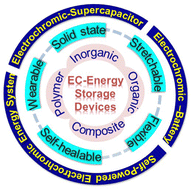Recent progress in electrochromic energy storage materials and devices: a minireview
Abstract
Integration of several functionalities into one isolated electrochemical body is necessary to realize compact and tiny smart electronics. Recently, two different technologies, electrochromic (EC) materials and energy storage, were combined to create a single system that supports and drives both functions simultaneously. In EC energy storage devices, the characteristic feature of EC materials, their optical modulation depending on the applied voltage, is used to visually identify the stored energy level in real time. Moreover, combining energy-harvesting and EC storage systems by sharing one electrode facilitates the realization of further compact multifunction systems. In this minireview, we highlight recent groundbreaking achievements in EC multifunction systems where the stored energy levels can be visualized using the color of the device.

- This article is part of the themed collections: Horizons Community Board collection: new trends in energy storage and harvesting and 2023 Materials Horizons Lunar New Year collection


 Please wait while we load your content...
Please wait while we load your content...